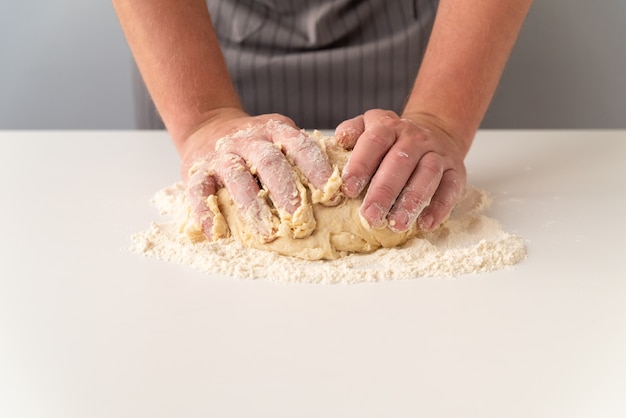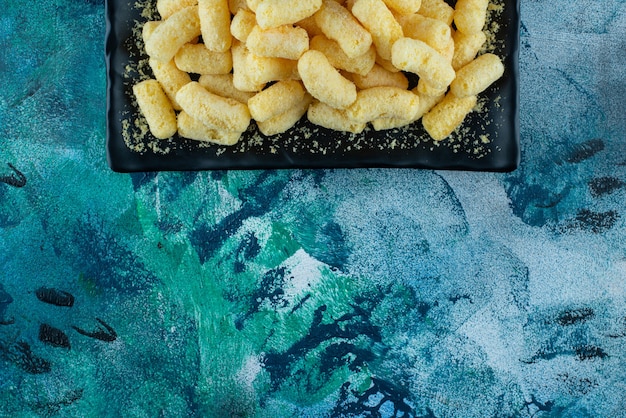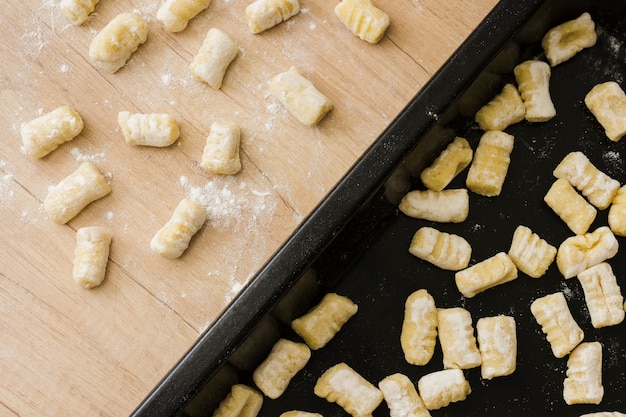Ah, gnocchi. Those little pillows of potatoey goodness that melt in your mouth. Honestly, I've been obsessed with them since I first tasted them in a tiny trattoria in Rome. It was like a revelation - these little clouds of flavour were nothing like the dense, heavy pasta I was used to. I just had to learn how to make them myself, and I've been perfecting my recipe ever since.
Now, I'm not going to lie, making gnocchi can be a bit of a challenge. It's all about finding that sweet spot between a delicate texture and a firm enough structure to hold its own in a sauce. But trust me, it's worth the effort. Once you nail it, you'll be whipping up batches of these little beauties in no time, and your friends and family will be begging for more.
So, grab your aprons, folks, because we're about to embark on a gnocchi journey together. I'll guide you through every step, from choosing the right potatoes to creating the perfect sauce. By the end of this guide, you'll be a gnocchi pro, ready to impress even the most discerning Italian foodie.
(Part 1) Choosing the Right Potatoes

Why Some Potatoes are Better Than Others
I know, it sounds a bit picky, but choosing the right potatoes is absolutely key to making perfect gnocchi. You want potatoes that are starchy and fluffy, with a low moisture content. This will give your gnocchi the right texture – light and pillowy, not dense and gummy.
Think of it like this: the starch in the potatoes acts like a binder, holding the gnocchi together. But too much moisture can make the dough sticky and difficult to work with, and the finished gnocchi will be heavy and lack that desirable airy texture.
And trust me, I've tried it all. I've used waxy potatoes, which are great for mashing, but they just don't give you the airy texture you need for gnocchi. They tend to be more dense and result in gnocchi that's more like a chewy ball than a fluffy pillow. I've even tried using sweet potatoes, which is a fun twist, but it's not the classic gnocchi experience. Stick to the starchy ones, and you'll be golden.
The Best Potatoes for Gnocchi
So, what are the best potatoes for gnocchi? Here's my top pick:
- king edward: This is my absolute go-to. It's got that perfect balance of starch and moisture, resulting in a fluffy, light gnocchi.
- maris piper: Another excellent choice, known for its starchy nature and ability to hold its shape. This makes them great for shaping into gnocchi and prevents them from becoming too mushy during cooking.
- Desiree: This one has a bit more moisture than the others, so you might need to adjust the flour slightly. But it's a good option if you can't find King Edwards or Maris Pipers.
Avoid using potatoes with a waxy texture like:
- Charlotte: These are best for salads or roasting as they have a delicate flavour and tend to hold their shape well.
- New Potato: These are delicious boiled or roasted, but they lack the starch content for making gnocchi.
- Red Bliss: These are often used for mashing due to their waxy texture. They're not ideal for gnocchi as they can make the dough too wet and sticky.
If you're ever unsure about a particular potato, check the packaging. It usually states whether the potato is best for baking, boiling, or all-purpose use.
(Part 2) Getting the Potatoes Ready

Boiling the Potatoes Perfectly
Now, the first step in making gnocchi is getting those potatoes perfectly cooked. Don't just throw them in a pot and hope for the best – there's a right way to do it.
First, give your potatoes a good scrub. We want them clean, but we don't want to damage the skin. The skin helps to keep the potatoes moist and prevent them from absorbing too much water during cooking. Now, add the potatoes to a large pot of cold salted water. The trick here is to start with cold water. This helps the potatoes cook evenly, ensuring that the inside cooks through before the outside becomes too soft. Bring the pot to a boil, then reduce the heat to a simmer and cook until the potatoes are tender. You can test this by poking a fork into them – it should go in easily. This usually takes about 15-20 minutes, but it can vary depending on the size of your potatoes.
Once they're cooked, drain them immediately and leave them to cool slightly. Don't leave them in the colander for too long though, as they'll start to steam and become soggy. The best way to cool them is to spread them out on a baking sheet for a few minutes.
Peeling and Mashing: The Perfect Consistency
Now that the potatoes are cooked, it's time to peel and mash them. While they are still hot, peel off the skin. Work quickly, as the potatoes will start to cool down, and you want them hot enough to mash easily. This will make the mashing process smoother, and it's crucial for creating the right texture for the gnocchi.
Now, it's time to mash the potatoes. You can use a potato masher, a fork, or even a ricer. I personally prefer a ricer for a really smooth and airy texture. The ricer pushes the potatoes through a fine mesh, creating a light and fluffy texture that's perfect for gnocchi. But if you're using a masher or fork, just make sure you don't over-mash them. You want some texture left in the potato – it'll give your gnocchi that characteristic chewiness.
As you are mashing, add a pinch of salt. This is really important as it will season the gnocchi and enhance its flavour. You can also add a touch of nutmeg, which adds a lovely subtle warmth. I usually add a pinch of nutmeg to my gnocchi as it complements the potato flavour and creates a more complex taste.
(Part 3) Making the Dough

Blending the Potato with Flour
Now, it's time to make the gnocchi dough. This is where things get a little bit tricky, but don't worry, it's not as complicated as it seems.
Start by adding the flour, bit by bit, to the mashed potato. You want to use enough flour to create a dough that's firm enough to handle, but not too dry. You can start with about 1 cup of flour, then add more as needed. I usually add about 1 1/2 cups, but the exact amount will depend on how much moisture is in your potatoes.
Now, here's where it gets fun (and slightly messy): Use your hands to gently combine the flour and potato. Don't overmix! You just want to bring it all together into a cohesive dough. Overmixing can develop the gluten in the flour, making the gnocchi tough. It's best to handle the dough as little as possible.
Checking the Texture: The Gnocchi Test
To make sure you have the right consistency, grab a small piece of dough. If it's too sticky, add more flour, a tablespoon at a time. If it's too dry, add a tablespoon of water. You want to find that perfect balance where the dough is pliable and smooth, but not too sticky or crumbly.
The dough should be soft and pliable, but firm enough to hold its shape. You should be able to roll it into a log without it sticking to your hands. It shouldn't be too sticky or too dry, and it should have a slightly rough surface. It's all about finding that perfect balance, my friend.
(Part 4) Shaping the Gnocchi
Rolling and Cutting: Creating the Signature Shape
Now, the fun part – shaping your gnocchi. It's really all about creating the classic little dumplings that are so satisfying to eat.
First, dust your work surface with flour. This will prevent the dough from sticking. Now, take your dough and roll it into a long log, about 1 inch thick. You can use a rolling pin for this, but I find it easier to just use my hands. Gently roll the dough back and forth, using your hands to create a smooth, even log.
Once you've got your log, use a knife to cut it into 1-inch pieces. This is where the magic happens. Take each piece of dough and roll it gently over a fork. This creates the signature grooves on the gnocchi, which helps them to hold onto the sauce and makes them look extra fancy.
Optional Step: Adding Texture with a Fork
If you want to add even more texture, you can use the tines of a fork to create ridges on the gnocchi. Simply press the fork into the top of each piece of dough, creating an indent that will allow the sauce to cling. I love the way this looks and feels in my mouth, so I always do it. This also helps to create a slightly more rustic look for your gnocchi.
(Part 5) Cooking the Gnocchi
Boiling in Salted Water
Okay, your gnocchi are ready to cook. Get a large pot of salted water boiling. Add the gnocchi to the boiling water, a few at a time. Don't overcrowd the pot, as this will make them stick together. The gnocchi need room to cook evenly and float to the surface.
The gnocchi are ready when they float to the surface. This usually takes about 2-3 minutes, depending on the size of your gnocchi. Once they float, scoop them out with a slotted spoon and set them aside.
The Secret to Avoiding Soggy Gnocchi
Here's a tip that makes all the difference – don't let the gnocchi sit in the water for too long after they float. They'll absorb too much water and become soggy. The goal is to get them cooked through but still have a firm texture. The best way to avoid this is to scoop them out as soon as they float and immediately toss them with your chosen sauce.
(Part 6) Choosing the Right Sauce
Simple Sauces for a Classic Feel
Now, let's talk about sauces. There are endless possibilities, but some classic pairings are always winners.
For a simple and elegant sauce, go for a butter and sage sauce. Just melt some butter in a pan, add some fresh sage leaves, and toss with the cooked gnocchi. It's a timeless combination that lets the flavour of the gnocchi shine through.
Another classic is a tomato sauce. Use a good quality canned tomato sauce or make your own. This sauce can be as simple or as complex as you like. Add some garlic, onions, and herbs for more depth. A simple tomato sauce can be a great way to highlight the potato flavour of the gnocchi.
Creamy and Cheesy Sauces
If you're feeling adventurous, try a creamy sauce. Gnocchi are perfect with a creamy pesto sauce, a mushroom cream sauce, or a cheesy gorgonzola sauce. Just make sure you don't add the sauce until the gnocchi are cooked and drained, or it will become too watery.
You can also go for a simple but decadent four cheese sauce with parmesan, mozzarella, ricotta, and pecorino. Just be careful not to overdo it with the cheese – a little goes a long way. The creamy texture of these sauces complements the fluffy gnocchi beautifully.
(Part 7) Serving Your Gnocchi Masterpiece
Plating and Garnishing
Okay, you've created your gnocchi masterpiece. Now, it's time to present it beautifully. I love to serve gnocchi on a rustic wooden platter, but you can use any dish you like.
Once you've arranged the gnocchi on your platter, drizzle it with your chosen sauce. Then, garnish it with a sprinkle of fresh herbs, like parsley or basil. You can also add a drizzle of olive oil and a sprinkle of grated parmesan cheese. A touch of parmesan adds a salty and cheesy flavour that contrasts nicely with the richness of the gnocchi.
Pairing Gnocchi with Sides
Gnocchi are delicious on their own, but you can also serve them with a side dish. A simple side salad with vinaigrette dressing is always a good choice. You can also serve them with roasted vegetables, like asparagus or zucchini, or with a side of grilled chicken or fish.
(Part 8) Tips and Tricks
Mastering the Art of Gnocchi
Here are a few tips and tricks that I've learned over the years:
- Use fresh ingredients: The quality of your ingredients will make all the difference. Use fresh potatoes, fresh herbs, and good quality flour for the best results. Using good quality flour is essential for creating the right texture for your gnocchi.
- Don't overwork the dough: Overworking the dough will make your gnocchi tough. Just gently bring it together and don't knead it like you would bread dough. The less you handle the dough, the more tender and fluffy your gnocchi will be.
- Don't overcrowd the pot: Adding too many gnocchi to the boiling water at once will make them stick together. Cook them in batches if necessary. This ensures that they cook evenly and prevents them from becoming mushy.
- Use a slotted spoon: A slotted spoon is the best way to remove the gnocchi from the boiling water. It helps to drain the excess water and prevent them from becoming soggy.
- Serve immediately: Gnocchi are best served immediately after they're cooked. They'll start to dry out if they sit for too long. Serve them hot and fresh for the best experience.
(Part 9) FAQ's
What if my gnocchi are sticky?
If your gnocchi are sticky, it means they have too much moisture. You can try adding a little bit more flour to the dough, a tablespoon at a time, until it's less sticky. If that doesn't work, you can also try using a bit less water when boiling them. The key is to find the right balance of moisture in the dough to prevent sticking.
What if my gnocchi are too dry?
If your gnocchi are too dry, it means they don't have enough moisture. You can try adding a tablespoon of water to the dough at a time until it's less dry. If that doesn't work, you can also try adding a little bit more potato to the dough. Adding a bit of moisture to the dough helps to create a smoother and more pliable texture.
Why are my gnocchi falling apart?
If your gnocchi are falling apart, it might be because you overcooked them. You want to cook them just until they float to the surface. If they're still falling apart, it might also be because you didn't use enough flour in the dough. Make sure you cook the gnocchi until they float, and ensure you have the right flour to potato ratio in the dough.
What are some alternative sauces for gnocchi?
There are so many great sauces you can use with gnocchi! Besides the classic options, here are a few other ideas:
- Mushroom Sauce: Saute mushrooms with garlic and herbs, then add cream or broth for a rich sauce. This earthy sauce pairs well with the potato flavour of gnocchi.
- Walnut Pesto: This is a creamy and nutty pesto that's delicious with gnocchi. The richness of the walnuts complements the light texture of gnocchi beautifully.
- Spinach and Ricotta Sauce: This is a light and flavorful sauce that's perfect for spring. The creamy ricotta and fresh spinach create a delicate and vibrant sauce for your gnocchi.
What can I do with leftover gnocchi?
Don't worry, leftover gnocchi is a good thing! You can refrigerate it for a few days and reheat it in a pan with a little bit of butter or oil. It's also delicious served cold in a salad. You can even add it to soup or stew. Gnocchi can be used in a variety of ways, making it a versatile ingredient to have on hand.
I hope you've enjoyed this ultimate guide to making perfect gnocchi! Remember, the key is to be patient and have fun. If you follow these tips, you'll be whipping up delicious gnocchi in no time.
Buon appetito!
Everyone is watching

Corn on the Cob: The Ultimate Guide to Perfectly Cooked Ears
Healthy MealsAh, corn on the cob. Just the name evokes images of sunny days, barbecues, and that sweet, juicy flavour that ...

Perfect Pork Roast Oven Cooking Time: A Guide to Delicious Results
Healthy MealsThere's something truly satisfying about a perfectly roasted pork. The aroma alone is enough to make your mout...

Ham Cooking Time: How Long to Bake, Smoke, or Boil a Delicious Ham
Healthy MealsAh, ham. It's a classic, isn't it? A real crowd-pleaser, especially around holidays. And when done right, it'...

Scallops: The Ultimate Guide to Perfect Cooking
Healthy MealsAh, scallops. Those delicate, sweet, and utterly delicious morsels of the sea. They hold a special place in my...

Spaghetti Squash: The Ultimate Guide to Cooking and Serving
Healthy MealsRemember that time you saw spaghetti squash at the supermarket, looking all bumpy and strange, and thought, "W...
